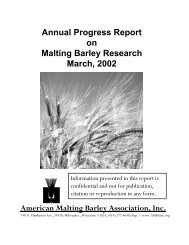Annual Progress Report on Malting Barley Research March, 2007
Annual Progress Report on Malting Barley Research March, 2007
Annual Progress Report on Malting Barley Research March, 2007
Create successful ePaper yourself
Turn your PDF publications into a flip-book with our unique Google optimized e-Paper software.
enzyme it encodes.<br />
We found that seven α-glucosidase genes are expressed in barley seeds that<br />
have been germinated for three days (see 2004-2005 progress report). Only <strong>on</strong>e of<br />
these, Agl1, has been previously reported (Tibbot and Skadsen, 1996). Four of these<br />
seven genes, including Agl1, were abundantly expressed and three had low levels of<br />
expressi<strong>on</strong>. The potential roles of the novel α-glucosidases were unknown as were<br />
any characteristics of their gene expressi<strong>on</strong> or of the expressed proteins. In this report<br />
we present results of studies to characterize expressi<strong>on</strong> of Agl2 , named AglX in the<br />
2004-2005 progress report, and compare its expressi<strong>on</strong> to that of Agl1.<br />
Methods<br />
Quantitative RT-PCR (qtRT-PCR)<br />
Total RNA was extracted from 3 – 9 individual samples using Plant RNA reagent<br />
from Invitrogen (Carlsbad, CA) according to the manufacturer’s instructi<strong>on</strong>s. Purified<br />
RNA was treated with DNAse using RNeasy mini kits (Qiagen, Valencia, CA) according<br />
to the manufacturer’s instructi<strong>on</strong>s. For cDNA synthesis, three independent reacti<strong>on</strong>s<br />
were undertaken for each tissue, 1 µg of total RNA for each reacti<strong>on</strong> was reverse-<br />
transcribed using Superscript III (Invitrogen) and random hexamers according to the<br />
manufacturer’s instructi<strong>on</strong>s. For qtRT-PCR, 1 µL of a 1:5 diluti<strong>on</strong> of the cDNA was<br />
used in a reacti<strong>on</strong> which also c<strong>on</strong>sisted of 5 µL of SYBR premix ExTaq (Takara mirus<br />
bio, Madis<strong>on</strong>, WI), 0.4 µL each of the forward and reverse primers at 5 µM each, 0.2 µL<br />
of ROX reference dye II, and 3 µL of water. Reacti<strong>on</strong>s were performed <strong>on</strong> an Applied<br />
Biosystems 7300 Real-Time PCR system using the following schedule: 10 s at 95°C<br />
followed by 40 cycles of 5 s at 95°C then 31 s at 60°C. A melting curve was obtained<br />
from the product at the end of the amplificati<strong>on</strong> by heating from 70°C to 99°C.<br />
Cl<strong>on</strong>ing of the putative promoters<br />
Genomic DNA was purified from 7 day old seedling leaves using DNeasy Mini<br />
kits (Qiagen) according to the manufacturer’s instructi<strong>on</strong>s. Purified genomic DNA was<br />
digested with the restricti<strong>on</strong> enzymes to create blunt-end fragments that were then<br />
117
















